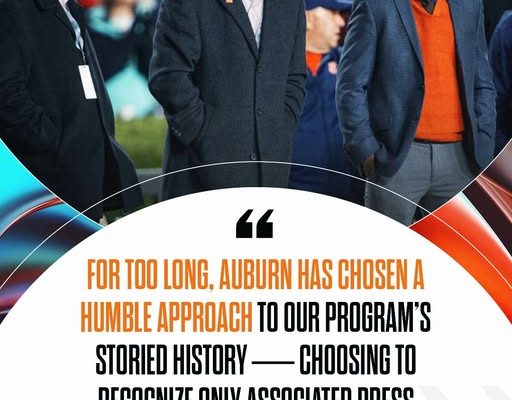After nearly seven decades, a new controversy has emerged in the world of college football history as the Auburn Tigers are officially moving to recognize the 1958 national championship as part of their program’s legacy. For many, this decision seems unusual, considering that the 1958 title has long been associated with LSU, who went 11-0 that season and were named national champions by the Associated Press and the Coaches Poll. But in the modern era of revisiting and reassessing historical records, schools like Auburn have taken the opportunity to claim retroactive national titles based on recognized mathematical rating systems, selectors, and retroactive polls that existed outside of the traditional AP and Coaches models. This movement speaks not only to Auburn’s rich history but also to the ongoing conversation in college football about how championships were awarded prior to the advent of the Bowl Championship Series and, later, the College Football Playoff.
To understand why Auburn is making such a bold move now, it is important to first revisit the context of the 1958 season. The Auburn Tigers, coached by Ralph “Shug” Jordan, were a dominant program in the 1950s, having already claimed a recognized national championship in 1957 when they went undefeated. The 1958 team, while not unbeaten, finished with an impressive 9-0-1 record. Their only blemish came in a 7-7 tie against Georgia Tech. Throughout that season, Auburn’s defense was suffocating, holding six opponents to a touchdown or less, and their overall dominance placed them at the very top of several mathematical rating systems used at the time. One of those systems was the Montgomery Full Season Championship Index, which named Auburn the No. 1 team in the nation for 1958. However, the AP and UPI polls crowned LSU, who went undefeated and capped their season with a Sugar Bowl victory, the undisputed national champion in the eyes of the mainstream.
For decades, Auburn fans and the program itself acknowledged 1957 as their only mid-century title. But in recent years, the NCAA itself has included Auburn as a recognized national champion for 1958 in its official record book, pointing to the mathematical rankings that awarded them the crown. Other schools, like Alabama, Minnesota, and Texas A\&M, have long claimed championships based on similar systems, even when they were not voted No. 1 by the AP or Coaches Poll. Auburn’s move is therefore not unprecedented, but it still sparks debate because LSU’s claim on 1958 has been strong, celebrated, and historically entrenched in college football lore. By staking their claim now, Auburn is attempting to rewrite a piece of history in their favor, while LSU supporters argue that no one who watched the 1958 season unfold would reasonably place Auburn ahead of the undefeated Tigers from Baton Rouge.
The timing of Auburn’s recognition is also noteworthy. Programs across the country have increasingly embraced retroactive championships to bolster their historical prestige, often in part to keep pace with rivals. Alabama, Auburn’s fiercest rival, claims 18 national championships, many of which are contested or retroactive. By adding 1958, Auburn not only strengthens its own resume but also narrows the narrative gap with Alabama’s storied legacy. For Auburn fans, it offers an additional piece of pride in a rich era of the program, while for critics, it represents the kind of historical revisionism that cheapens the concept of a national title. At the same time, Auburn is merely following the trend set by the sport itself, where the absence of a clear playoff structure before 1998 left many championships open to interpretation.
What is most fascinating about Auburn’s 1958 claim is that it underscores just how messy the history of college football championships really is. Before the BCS era, there was no definitive mechanism to crown a national champion. The AP Poll began in the 1930s, and the Coaches Poll came shortly thereafter, but both were subject to human bias, regional allegiances, and the limitations of media coverage at the time. Mathematical rating systems like the Dunkel Index, the Sagarin Ratings, and others often produced different outcomes than the AP or Coaches polls. In some seasons, there were as many as five or six different teams that could legitimately claim a national championship based on one selector or another. For Auburn in 1958, the Montgomery Index gave them the nod, and now, decades later, they are treating that recognition as part of their football heritage. This is no different from how schools like Alabama retroactively claim titles from years when they were not the consensus No. 1 but were recognized by at least one mathematical or historical selector.
For LSU, the 1958 season remains iconic. It was the year that Billy Cannon, who would go on to win the 1959 Heisman Trophy, emerged as a household name. It was the year that LSU capped off an undefeated run with a Sugar Bowl victory, solidifying Paul Dietzel’s place in Tiger lore. Their claim has never been contested seriously until now, and LSU fans understandably feel that Auburn’s recognition of 1958 is an attempt to diminish one of the proudest moments in their program’s history. LSU was the consensus champion, something Auburn was not, and that distinction carries enormous weight. Yet, college football’s history has always been marked by dual champions and disputed claims. Michigan and Nebraska split the 1997 title between the AP and Coaches polls. USC and LSU split in 2003. Alabama itself shares several titles with other schools. In that light, Auburn’s addition of 1958 is less about taking away from LSU and more about ensuring their place in the conversation of that season’s best teams.
The decision also raises questions about what it truly means to be a national champion. Is it about being the consensus No. 1, as LSU was in 1958? Or is it about being recognized by any NCAA-listed selector, as Auburn was? College football has never had the kind of clarity that other sports enjoy with playoff systems and championship games. Even the BCS era, which was meant to settle disputes on the field, ended in controversy, as seen in 2003. The College Football Playoff has solved some of these issues, but its four-team format has still left out worthy contenders. The upcoming expansion to a 12-team playoff promises more inclusivity, but retroactive claims like Auburn’s serve as a reminder of just how unsettled the past really is. By claiming 1958, Auburn is not rewriting history so much as acknowledging the messiness of it, asserting that their 9-0-1 season deserves more recognition than it received at the time.
From a broader perspective, Auburn’s move is also about branding, recruiting, and prestige. Championships—recognized or retroactive—carry weight in college football, perhaps more than in any other sport. They influence the perception of programs, attract recruits, and provide talking points for fans and alumni. By adding another championship to its record, Auburn can market itself as a program with not just two national titles but three, joining a more elite tier historically. In the highly competitive world of SEC football, where tradition and bragging rights are everything, that matters. Whether or not outsiders agree with Auburn’s claim, the internal benefits of boosting the program’s historical standing are undeniable.
Still, the move invites criticism. Detractors argue that retroactive claims dilute the meaning of championships by allowing schools to cherry-pick favorable historical selectors while ignoring those that do not support their case. They argue that Auburn had its chance in 1958 and that LSU, undefeated and undisputed, earned the crown. This criticism is not without merit. Yet, the precedent has long been set by other programs, and the NCAA itself recognizes Auburn’s 1958 title in its official listings. That recognition gives Auburn legitimacy in its claim, even if it remains controversial.
As college football continues to evolve, these retroactive claims will likely become more common. Fans and historians will debate them endlessly, but at the end of the day, they are part of what makes the sport so uniquely passionate and divisive. Auburn’s recognition of 1958 is less about changing history and more about telling their own version of it, ensuring that their achievements are remembered alongside those of LSU. For Auburn supporters, it is a long-overdue acknowledgment of a team that dominated its schedule and deserved better than to be forgotten in the shadow of an undefeated rival. For LSU supporters, it is a reminder that history is never as secure as it seems, that even an undisputed title can face challenges decades later.
In the end, the 1958 Auburn Tigers will now be remembered as national champions, at least in the eyes of their own program and the NCAA’s record book. Whether the broader college football community accepts that claim is another matter entirely. But one thing is certain: nearly 70 years later, the debate over who truly deserved the crown in 1958 has been reignited, proving once again that in college football, the past is never really past. Auburn’s decision ensures that their 1958 team, once overlooked, now has a place in the national conversation, and whether you agree with their claim or not, that in itself is a victory.



